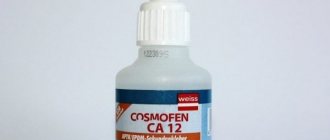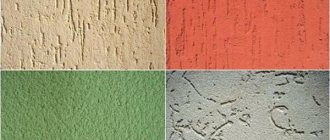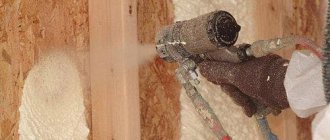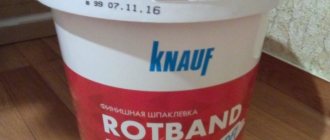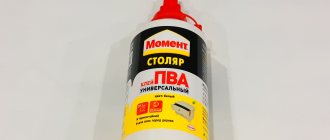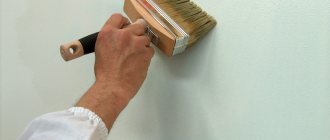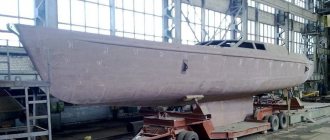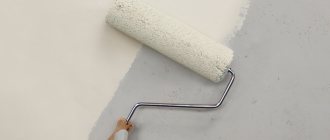Today, to extend the significant service life of certain elements and parts, a special paint coating is used. As a rule, in practice, the properties of the paint itself are not sufficient, which is why the surface is first subjected to a primer to improve adhesion. At the moment, there are various primer options, but the water-dispersive primer deserves the greatest interest. In this case, it is necessary to consider what a water-dispersion primer such as ceresit CT 17 is, and in addition its consumption per 1 m2.
Purpose and application
This composition of Ceresit has a universal purpose. As a rule, this type of primer is used for pre-coating walls when carrying out interior and exterior work before subsequent finishing:
- For treating concrete, cement and gypsum surfaces before future decorative finishing.
- As a composition to improve the adhesion of absorbent surfaces and, if necessary, treatment before painting.
- For upcoming painting, plastering work, and also gluing wallpaper to the surface.
- Immediately before applying the appropriate putty or other composition to the bearing surface.
In general, this substance is used for surfaces that reduce the adhesion of other primers that do not have similar properties as the option under consideration from the manufacturer Ceresit.
Important. This composition has a certain GOST, but the main characteristics are based on practical application, which is why the solution has a universal purpose.
What is Ceresit primer?
Deep penetration antiseptic primer is a water-dispersion mixture, the composition of which contains polymers and various additional components that have a positive effect on the performance properties of the material. The product is applied to the surface, as a result of which it forms a very thin but durable film. The task of the composition is as follows:
- the material increases the degree of adhesion to facing building materials;
- deep penetration primer helps strengthen the base, gluing crumbling elements, both on the outer surface and inside;
- reduces absorbent properties, which consequently reduces the consumption of liquid facing coatings;
- eliminates the possibility of the formation of mold, corrosion, fungi and other harmful bacteria.
The soil increases the service life of the cladding and saves the consumption of liquid materials. All of these factors were obtained thanks to the high quality of the products and the correctly selected proportions of the constituent components. Each product under this brand has a certificate of compliance with state and international standards.
Composition and technical characteristics
This version of the device for treating walls is used quite often in practice due to its good properties, and in addition, the appropriate solution is made from the following components:
- As a rule, the base here is acrylic resin, which has the necessary viscosity;
- in addition, the substance contains an organic solvent, as well as the necessary enzymes;
- the primer contains the necessary polymers, as well as other organic compounds and substances, and also water;
- Separately, we should highlight the presence of such a component as a synthetic hardener, which promotes rapid hardening.
This substance is used everywhere in construction, for the reason that the applied layer dries out in two hours. In addition, there is a relatively low consumption and the possibility of use at temperatures from 5 to 35 degrees.
Important. When using this substance, consumption can vary significantly depending on the application option, and also the tool used during operation.
Consumption per 1m2
This substance has the necessary properties and composition to significantly reduce the consumption of the solution during use. Typically, the primer coat can be applied using a brush, roller or paint sprayer. In practice, when applying a substance to a surface, depending on the design option, as well as the method of application, from 100 to 200 grams can be consumed. Such figures are stated directly by the manufacturer, however, in fact, the consumption can increase up to 250 grams per square meter, in the case of an inexperienced specialist.
Types and compositions of primers
Today, the industry produces many types of primers, both highly specialized and universal. Specialized compositions are designed for a specific type of substrate or properties of the subsequently applied material:
- Deep penetration primers used for porous materials - aerated concrete, gypsum, plaster.
- Film-forming primers that improve the adhesion of the applied material to the base surface.
- Anti-corrosion, protecting the base from moisture.
- Primers with antiseptic or fungicidal additives.
Ceresit ST 17 10 l
Primer components are alkyd compounds, drying oils, mineral and synthetic prepolymers, but universal acrylic primers are most widely used. This type includes Ceresit ST 17 primers. The composition of the primers, in addition to the main component, includes substances capable of forming durable films, pigments, and other modifying additives.
Peculiarities
This type of substance, unlike other primer options, has a number of nuances. Let's consider some features regarding the use of such surface coating:
- First of all, it is necessary to highlight the need to use a sprayer, since the composition is quite liquid;
- For work, you should use a small container, since the solution quickly hardens when in contact with air;
- this substance is not highly toxic, but there is a strong characteristic odor;
- the work is carried out on a fully prepared surface, otherwise the result will not be achieved;
- When carrying out work, spray technology should be taken into account depending on where the treatment is carried out (outside or inside).
Separately, special attention should be paid to the spray device itself. It must be periodically moistened with a solvent to prevent hardening.
Important. If you use a brush or roller, you should use varieties made from natural bristles, since synthetic products harden faster when exposed to soil.
Feedback on features of use
Ceresit CT 17 should be applied after thorough initial surface preparation. As home craftsmen recommend, it is necessary to remove debris and dust from the foundations. Unevenness and cracks should be covered with appropriate means. The primer can strengthen the surface, but if there are chips and areas that are prone to collapse, they must be removed. Application of primer, as consumers advise, should be done using the following tools:
- brushes;
- brushes;
- rollers.
The start of work should be accompanied by testing the surface for absorption ability. If it is high enough, then the coating should be applied in 2 layers. The first stage involves a passage using an aqueous emulsion solution. Drying will take 4 to 6 hours, then the next stage is carried out. The fixing layer is applied undiluted.
The above-mentioned drying period, according to consumers, is relevant if the humidity and temperature in the room are normal. The Ceresit CT 17 primer must be washed off the tools after work. For this you need to use water. Otherwise, the working surfaces of the tools will become unusable, and their reuse will be impossible. PPE will be additional precautions. You need to protect exposed skin with gloves, a respirator and protective clothing.
Advantages and disadvantages
This type of primer has a number of positive qualities, but there are also some disadvantages. Let's take a closer look at the main positive qualities of the substance:
- this type of primer is universal and suitable for treating any surface indoors or outdoors;
- the composition is characterized by improved adhesion and, in addition, rapid hardening, which significantly saves time during work;
- these substances are not very expensive, which allows them to be used on any budget;
- This coating option is easy to apply even by inexperienced specialists, or by those performing repair work for the first time.
Despite a number of advantages, there are some disadvantages regarding this substance. Small temperature range for coating. The composition penetrates deeply, which may result in overconsumption. This substance has a strong odor that can cause poisoning.
Scope of application and properties of the primer Ceresit ST 17
The water-based acrylic primer Ceresit ST 17 has the technical characteristics of film-forming compositions of deep penetration, it has a wide range of applications:
- Preparation for finishing surfaces made of concrete, cement plasters and screeds, gypsum putties, plasterboard, foam concrete, silicate or red brick, artificial and natural stone, fiberboard, chipboard, OSB before plastering, puttying and other finishing work.
- Bonding loose surfaces. Particles of loose surfaces firmly adhere to the base, causing it to become rough, which increases the adhesion of materials.
Ceresit water-dispersed compositions are not used when working with metal due to corrosion.
Processing of porous foam concrete
Technical characteristics of the primer Ceresit ST 17:
- Externally, it is a liquid with a yellow tint, packaged in containers of 2.5-10 liters. They produce 2 types: “Summer” and frost-resistant Ceresit ST 17 “Winter”. The shade is due to small additions of drying oil, alkyd and ebonite resins.
- Improves the holding properties of tile and wallpaper adhesives.
- Penetrates deeply into the base material, thereby reducing the absorption intensity of porous materials.
- Reduces the consumption of expensive paints and varnishes due to fewer layers required for high-quality and uniform painting.
- Allows you to apply leveling mixtures in a thin layer without the risk of them drying out and cracking.
- It does not contain organic volatile solvents, therefore it does not have a pungent odor.
- Available in the form of ready-made solutions or in the form of concentrates diluted with water.
- The absence of pigments allows you not to worry about the possibility of distortion of the color of paints or translucent material.
- The treated area is visually distinguished by its characteristic shine.
- Can be used in the installation of heated floors.
- Used for outdoor work as it is frost resistant.
- Material consumption – 1.2 l/m2.
Acrylic primers generally do not allow freezing during storage. If storage conditions do not guarantee a constant above-zero temperature, you should buy the Ceresit CT 17 “winter” option.
Ceresit CT 17 winter
Tips and recommendations for use
In order to properly coat the surface before the upcoming treatment, it is necessary to adhere to a number of recommendations for carrying out the arrangement with soil, namely:
- Immediately before work, the surface must be thoroughly prepared.
- It is imperative that this composition be thoroughly mixed before installation.
- When spraying, you should use a respirator and other protective equipment to avoid health problems.
- The device is applied in several layers, while the subsequent primer coating is applied after complete drying.
- As a rule, experts recommend applying 3-4 layers of primer to the coating, depending on its structure and properties.
If you take into account all these expert tips, you can properly and appropriately treat the surface using this type of paint coating.
Important. To significantly reduce the consumption of this component, you should use a sprayer and spray from a distance of 20-30 centimeters.
Flaws
Despite the high quality of the Ceresit CT 17 primer, it has disadvantages.
- The yellow color of the soil is very rich, so it is difficult to cover it with anything.
- This is expensive soil. There are more affordable analogues. They differ only in the absence of yellow pigment in the composition.
- You need to work with the primer very carefully, do not spill the composition on the window sills or floor, as it is difficult to remove.
- After drying, the soil does not smell, but during processing the smell of hydrogen sulfide may be felt.
Feedback on consumption
The Ceresit CT 17 primer, according to consumers, can be used in different volumes, which depend on the absorbency of the wall. Typically, according to consumers, about 200 ml of the composition is needed per 1 m2. If work is carried out to reduce water absorption, then the flow rate should be increased. This, according to buyers, allows you to fill the channels and pores inside the concrete.
